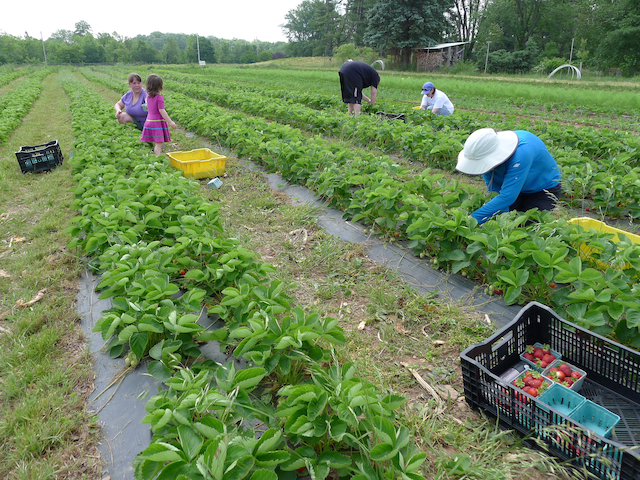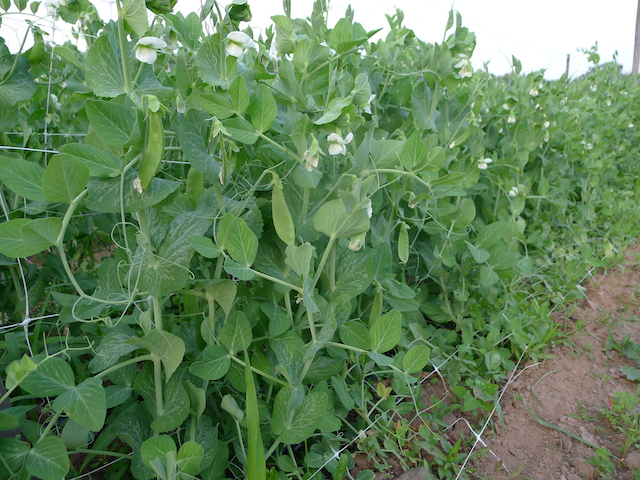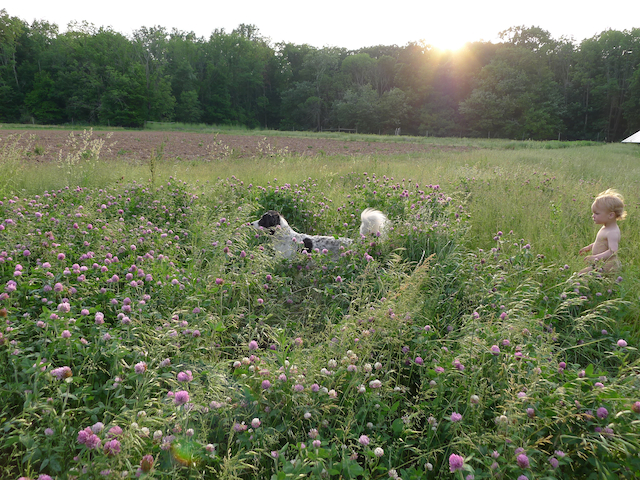
We warmly welcome succulent sweet strawberries and peas

CSA members harvest strawberries for the next CSA pick up during a weekend workshift.

Trellised snow peas will be ready for picking this week.
News
Notes From The Field
Rain in the Forecast
By Derek McGeehan
Rain in the Forecast
By Derek McGeehan
I'll believe it when I see and feel it! We've temporarily suspended the irrigation schedule in anticipation of this rain event and we're hoping it delivers a slow and soaking rain since the ground is basically locked up like concrete right now. I had been wondering when we would start to see the effects of the drought on the perennial vegetation around the area and to my eyes it seems noticeable now. The slight curl of leaves on young trees, grass and clovers growing much more slowly, the green shine of spring dissipating and making way for the brown of a dry summer. Perhaps this rain is coming just in time, but we've been fortunate to irrigate and grow some tasty spring greens and other crops.

Frolicking dog and boy in a red clover patch as the sun sets makes for a nice scene.
One thing dry weather allows for is the concentration of flavor, especially in the strawberries. I really can't believe how good they taste, plus the dense and succulent texture that explodes and melts in the mouth. Strawberry season has to be the best time of year. With this rain event and drop in temperatures we're hoping the picking season lasts as long as possible, say 3-4 weeks. Peas are starting to ripen and plump and will appreciate a good soaking and cooler weather also. However, summer squash is starting to flower and fruit and is just loving the warmth. Perhaps these will make an appearance in shares later this week or next week.
Now that June is here our spring planting mindset is just about over and we're now thinking about seeding, prepping, and planting for the late summer and fall. Cabbage, fennel, celery, kale, broccoli, cauliflower, chard, and rutabaga all must be seeded and planted over the next 6 weeks or so. From a field preparation and planting perspective, we're at least half way through the groundbreaking workload of the growing season even though the harvest season has just begun. The benefits of a dry April and May will be felt for much of the season. Plowing and working the soil with the tractor when it is dry has humongous benefits on our farm. Our soils have a high clay and magnesium content that basically can harden into little rocks when the ground is worked when wet and then dries out. Last season we had the opposite spring weather; it was cold and wet for much of April and May. Working the soil and planting in those conditions is difficult and unfriendly. So, I guess there is always something to be thankful for, even though this year has had its own share of stresses, albeit slightly different ones.

Expected Harvest
New: kale, peas, strawberries!
By Derek McGeehan
New: kale, peas, strawberries!
By Derek McGeehan
Harvest #3 (Week A) should include butterhead lettuce, romaine lettuce, mini lettuce, radishes, turnips, bok choy, arugula, baby kale, parsley, strawberries, and a chicory (endive, escarole, dandelion). U-pick should include strawberries, peas, perennial herbs, dill, and cilantro.

2015 Workshop #1: "Now What?!" Please join us on Saturday, June 13th from 2 to 4 PM.
By Gia Yaccarino
By Gia Yaccarino
Maybe you are a new member. Maybe you've been a member for a while. Either way, this workshop is for you!
In the barn, everything made sense as you were putting your share into your bags to bring home. At home, once you began unpacking, it suddenly became very overwhelming. We have all been there.
Let us help you make the most of your farm share.
Being a member of a CSA opens the door to so many topics. We will talk about:
- Resources: books, websites, Anchor Run CSA website (Recipes and Veggies 202 it has pictures!!)
- How to keep your veggies as fresh as possible once they are in your refrigerator.
- The pros and cons of different preservation techniques (freezing, canning, dehydrating).
- Tools of the trade, which I find invaluable.
- Before you compost: radish greens are edible!
- Composting: Composting at the farm; what and what not to include in a compost pile; vermicomposting.
- Solar Cooking
Hopefully this will pique your interest for the next workshop on Sunday, June 28th Recipes Tried and True. We will share the recipes from our farm shares that our families love. And by share I mean taste and provide copies of the recipes. Pestos - don't limit yourself to basil! What to do with all that Bok Choy! Veggie Hash! The list goes on! Stay tuned for the time of this future event.

Farm potluck gathering meal
By Derek McGeehan
By Derek McGeehan
Potluck events allow us to partake in good conversation with fellow CSA members, to share food prepared from farm bounty and elsewhere, and to spend some quality time sitting outside while enjoying the farm. Bring a dish to serve six and your own beverages and place settings. The first potluck of the season takes place Sunday, June 7, at 5pm under the pavilion.

Remember your bags and scissors!
By Derek McGeehan
By Derek McGeehan
When you come to the farm to pick up your produce or do your u-pick, it is essential for you to bring your own bags and scissors. Flowers and herbs need to be cut properly to ensure regrowth.

Member questions and tips
By Linda Dansbury
By Linda Dansbury
The last couple of years, I have received more emails from members on a weekly basis than I had in previous years, so I am starting a new column focusing on the ideas and questions from fellow members. Please email me your questions - there are no dumb questions. More than likely if you are wondering about something, other members are too. The community of the farm is a great place for exchanging information, so please send me ideas, questions, recipes, and cooking methods regarding the harvest and I will publish it in this space - lindadansbury@comcast.net. Please put Anchor Run in the subject line so I can easily find your email in case I miss it during the week. I will try to respond to you as soon as I can after you send me the message.
This week, I received 2 questions from members:
1. Elize Rupley sent me an email saying as a new member she was enjoying the herb garden and wondered what to do with lemon balm. Admittedly, I am not an expert on herbs - the only thing I really knew about it was that it is in the same family as the mints, so could be used as a "lemony" replacement for mint. Once I did a little research, I kind of said "duh" to myself, because lemon balm also contains the same calming properties of mint. Teas, tinctures have been made for centuries with this herb to calm the mind and spirit. Caution: if you have a thyroid condition, don't consume too much of this herb without talking with your doctor. From a culinary standpoint, add it to meats, vegetables, marinades as you would mint to impart a lemony flavor. A really cool thing about this herb, which I hadn't thought about until Elize sent me the question is that in eating more of a local diet, lemon balm, which grows prolifically, is a great replacement where a lemon would normally be squeezed: chop some up and finish fish or vegetables with it; add it to salad dressings instead of squeezing lemon juice. If any members have other great uses for lemon balm - please share with the membership!
2. Alice Maxfield asked about storage bags. She has been using special bags that she has reused for years but they are wearing out and the manufacturer has stopped making them. I know there are things that absorb ethylene, thereby slowing the deterioration of fruits and veggies in the fridge. There also used to be "greenbags" but don't know if they still exist. So, if any of you out there have a great storage solution for all of these greens other than cooking/using them as soon as possible, please send along. Sometimes, we just don't have time to preserve our harvest right away and good storage ideas would be appreciated.
I look forward to hearing from everyone during the season!

How I enjoyed my harvest
By Linda Dansbury
By Linda Dansbury
This is the third year for this weekly article. I began it on a whim 2 seasons ago, and have received so much positive feedback I have continued. It is not a recipe section, although I will reference some recipes. It is meant to be a place to find some ideas and inspiration. I hope it helps you to be inspired to send me emails on how you enjoy your harvest - methods, tips and/or recipes welcome - just make sure that the central ingredients are from the farm.
Butterhead, mini's, muir, radishes, chive blossoms - salads, salads, salads. With all the lettuces in the first 2 weeks, plus what I grow at my own home, we have been like rabbits eating salads. For these early season salads where the greens are tender and very mild, don't over dress them. I like a very light vinaigrette. For an onion flavor I have been adding chive blossoms (one of my favorites of the early season), but with the heat they are now finished, so I use chives. White wine, apple cider or rice vinegar and a light flavored oil, at a ratio of 1:3 or 1:4 is best. A little salt and pepper to finish is great. I think this coming week I will pick some lemon balm and add that to my mix instead of using fresh squeezed lemon!
Arugula - one of my favorite salad greens. I grow it and the farm does as well. This week with the heat and dryness, my arugula was starting to bolt, so I took a few minutes this weekend to give my arugula a "haircut" and made some arugula pesto. I currently have it in my fridge, but if I don't use it in the next day or two, I will freeze it for use later. We did have an arugula salad - very simple - salt, pepper, lemon juice and good quality olive oil. We served it along side a piece of grilled fish.
Custom greens - these are finished for now, but we will see them in the fall. I used some of them in my mixed greens salads and the rest combined with broccoli raab.
Broccoli raab - I prepared it the traditional way, sauteing garlic in olive oil and adding red pepper flakes, then adding the chopped up broccoli raab and cooking until just wilted. I skip the recommended step of cooking the green first - although still bitter, I find that the Anchor Run "raab" isn't as bitter as store purchased and when served alongside something like grilled sausages or chicken, and when mixed with other greens, it has a nice taste. Also, drizzling with olive and/or parmesan or other hard cheese softens the bitterness.
Bok Choy - as new members will see as the weeks progress, I cook a lot of southeast Asian dishes and this past week was no exception. My husband and I made a Thai soup that called for Chinese cabbage - so we thinly sliced one of the heads of bok choy and put that into the soup instead. One thing to think about as you look at recipes is to not look at them too literally; instead think about what might be similar enough from your harvest that you can use as a replacement for the exact recipe.
Strawberries - all gone - need I say more??!!

Perennial herb garden, peas and others!
By Linda Dansbury
By Linda Dansbury
Some weeks, I struggle to find what I should highlight. Other weeks, I have more things than space or time. Peas are one of the early veggies that kids and grown-ups alike enjoy. They can be eaten raw, in salads, or cooked - just make sure you don't overcook them. Peas only need a couple of minutes in the heat to sweeten them up. The farm has both sugar snap and snow peas - pick some of each and try some new recipes. There are several recipes on the website. Just go to the members page, then click on "search" and type in peas - you will find several recipes.
I asked Dana about the Rhubarb this past week and she said members can cut it as part of the perennial bed - so, while it is still good, please do so - I have added a neat, simple recipe for Rhubarb compote which can be served over ice cream, fish, chicken or even as a side dish.
I was reading a food section from the Courier and they highlighted an Asian style pasta salad which I think is perfect for the start of the pea season. Please use ingredients in the recipe list interchangeably. Instead of bean sprouts, cut bok choy thinly so you get a similar crunch. Although the dish calls for basil, which isn't available yet, use cilantro which is used a lot in Asian cooking. Instead of scallions, chives can be used, and sliced turnips would be a good substitute for the carrots.
I have another recipe I am making tonight for turnips and bok choy - if it is as good as it sounds, I will share it next week.

Want pastured meats delivered to Anchor Run? Order From Ledamete Farm!
Support local farms and farmers by purchasing their products here at Anchor Run. For more information and to pre-order, visit this link.

Recipes
V Oven Roasted Rhubarb Compote
From Melissa McClellan, Preserving by the pint; makes 2 half pint jars
1 pound rhubarb
1/4 cup granulated sugar
2 vanilla beans
1 lemon
1/4 cup granulated sugar
2 vanilla beans
1 lemon
Preheat oven to 350. Wash rhubarb and chop into 2-inch lengths. Arrange pieces in bottom of a baking dish.
Put sugar in a small mixing bowl. Scrape vanilla beans from the pods and add to the sugar. Using a fine rasp, grate in lemon zest. Toss well, then sprinkle over the rhubarb. Cut the lemon in half and squeeze the juice from one half over the rhubarb.
Roast for 20-25 minutes, until rhubarb pieces are tender but haven't lost their shape. When they are done, the pink stems color should have faded.
If you are canning for long-term storage, while the rhubarb is roasting, prepare a boiling water bath an 2 half-pint jars per recipe. process jars for 10 minutes. If not, it will keep in your fridge covered for 1 to 2 weeks.

Asian Noodle Salad with Shrimp and Snow Peas
From Diane Rossen Worthington via the Bucks County Courier Times; serves 4-6. Take the ingredients of this recipe as a guide - use whatever the farm has to offer at the time.
1 pound Chinese-style noodles or favorite pasta
1 Tablespoon canola oil
1 Tablespoon canola oil
Dressing:
1/4 cup canola oil
2 teaspoons dark sesame oil
1/4 cup rice wine vinegar
1 teaspoon Asian style chili paste (optional, but yummy))
1 Tablespoon fresh lime juice
1 Tablespoon honey
2 garlic cloves, minced - or less
1 1/2 teaspoons peeled, grated fresh ginger
1 Tablespoon finely chopped fresh basil - or cilantro
3 Tablespoons finely chopped fresh mint
Salt
1/4 cup canola oil
2 teaspoons dark sesame oil
1/4 cup rice wine vinegar
1 teaspoon Asian style chili paste (optional, but yummy))
1 Tablespoon fresh lime juice
1 Tablespoon honey
2 garlic cloves, minced - or less
1 1/2 teaspoons peeled, grated fresh ginger
1 Tablespoon finely chopped fresh basil - or cilantro
3 Tablespoons finely chopped fresh mint
Salt
1 pound medium cooked shrimp, crabmeat, chicken, or tofu cut into bite-sized pieces
2 medium carrots, peeled and shredded or a bunch of Anchor Run turnips, julienned
1 cup bean sprouts or 1 cup of thinly sliced bok choy
1/4 pound or more snow peas, stems removed and thinly sliced
2 medium carrots, peeled and shredded or a bunch of Anchor Run turnips, julienned
1 cup bean sprouts or 1 cup of thinly sliced bok choy
1/4 pound or more snow peas, stems removed and thinly sliced
Garnish
3 scallions, thinly sliced - or a bunch of chives chopped
Lime wedges
Sprigs of fresh mint
3 scallions, thinly sliced - or a bunch of chives chopped
Lime wedges
Sprigs of fresh mint
Cook noodles in a large pot until barely tender and still firm. Drain and rinse in cold water, drain again and toss with the canola oil so they don't stick together. In a small bowl combine dressing ingredients and toss with pasta. Add the shrimp/chicken, carrots/turnips. bean sprouts/bok choy, and peas, toss and adjust for seasoning. Put in fridge to chill.
To serve, arrange in a large serving bowl or individual bowls and top with garnishes.


